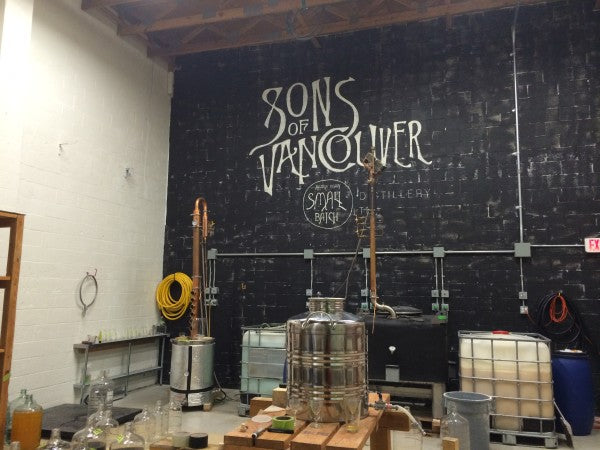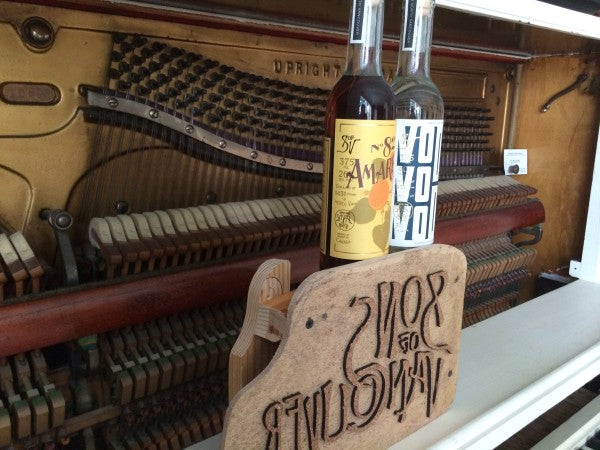Dialogue: Sons of Vancouver Bring Honour to the Vodka Name
The picturesque, residential streets of North Vancouver conceal an unexpected laboratory. A stone’s throw from neighbour’s front yards and picket fences sits Sons of Vancouver, a new craft spirits distillery owned and operated by long time friends James Lester and Richard Klaus. The two met in high school at a power mechanics course in Fort St. John, lost touch then crossed paths again while completing their apprenticeships in process control and instrumentation.
Having trained in the proper use of flow in oil and gas, they saw the immediate correlation to distilling processes and decided to mix their professional backgrounds with their passion for home brewing. And so on February 1st, 2015, Sons of Vancouver was born. Their now award-winning craft vodkas and amaretto are a culmination of countless sleepless nights, bus trips to Seattle to intern with the expert distillers at 2 Bar Spirits, and a series of experiment victories and mishaps. I spoke with James about the different characters of each of their spirits, how Sons of Vancouver is changing the face of the vodka tradition and gained several insights into the craft distilling scene.
I’ve had the impression, good or bad, that vodka is the clubbing drink of choice, but bourbon seems to carry more cache.
Don Draper does not order a vodka soda. There are just so many stories that I’ve heard that go, “I don’t drink vodka, I had a bad experience…” And it’s a similar thing with gin. I think a lot of people tried something when they were younger, drank way too much of it and just decided they don’t like it.
But there’s a huge wave of breweries. And with craft beer, you can open a small brewery and immediately you’re making something better than the big guys. The big guys don’t have the ability to change what they’re doing and certainly are not known for product quality. With spirits on the other hand, and mainly whiskeys, what they do, they’ve been doing for 200 years and are awesome at it. There are $60 bottles of whiskey that are phenomenal and a craft distiller could not make the same whiskey on the same platform for anywhere near the same price.
I think with established whiskeys, the quality is still there and the traditions are ingrained. Vodka isn’t particularly known for quality. Its tradition is folklore at this point – like an icy bottle from your Polish grandmother’s freezer.
What’s the difference between vodka and the infamous moonshine?
Moonshine is similar to vodka but it’s not flavourless and it’s made from corn. So it’s distilled to a lower percentage and a lot more flavour is left in there. I guess back in the day, corn was super easy to get and it imparts a really sweet, strong flavour, which is what bourbon is known for. But it’s left as a clear spirit. Vodka on the other hand, the idea is to make it flavourless and odourless. That is the definition of vodka.
Where do you see the future of vodka going?
I think vodka as a whole is on its way out. I think vodka lost about seven percent of its market share last year to bourbon. But with craft vodkas – like ours isn’t a neutral vodka, and it was never meant to be. That’s one of the reasons we went with a champagne yeast, we didn’t go with a traditional vodka yeast because we didn’t want to make something that had no flavour. Craft vodkas are on the up and up.
What was the inspiration behind the chili vodka and amaretto?
Chili vodka. There’s a cocktail book called Aphrodisiacs with a Twist – it was originally launched through a Kickstarter campaign by a gentleman in Seattle named Mark Sexauer. It’s a cocktail book but it’s broken up like a cookbook. There’s a drink here called Sadie’s Cousin – it’s jalapenos muddled with pineapple juice. It’s one of the best cocktails I’ve ever had in my life. The downside was, it took 15 minutes to make and you needed like an entire salad bar! So you could never order it a typical pub – you needed like a produce section! We wanted to streamline that.
 What we wanted to do was make a spirit that had the utility of the jalapeno slices infused in something. So we experimented with a pile of different chillies. We started with jalapenos, we went to scotch bonnets because they were the hottest thing we could find. We tried inferno peppers and serrano peppers. We settled on Thai Dragon chillies because there’s a heat that hits the back of your tongue and throat – it doesn’t burn your lips at all – you’re not going to end up red faced. But it really sits there and lingers and we found that it mixes well with a Caesar. By that one point, our goal was to eliminate tabasco sauce from a Caesar. What we wanted to do was to take that vinegar out of your cocktail. So chili vodka was something we just couldn’t buy – there was a gap in the market. It’s definitely our most polarizing product! And if you get some on your hands, don’t touch your eyes. It’s definitely not a sipping vodka.
What we wanted to do was make a spirit that had the utility of the jalapeno slices infused in something. So we experimented with a pile of different chillies. We started with jalapenos, we went to scotch bonnets because they were the hottest thing we could find. We tried inferno peppers and serrano peppers. We settled on Thai Dragon chillies because there’s a heat that hits the back of your tongue and throat – it doesn’t burn your lips at all – you’re not going to end up red faced. But it really sits there and lingers and we found that it mixes well with a Caesar. By that one point, our goal was to eliminate tabasco sauce from a Caesar. What we wanted to do was to take that vinegar out of your cocktail. So chili vodka was something we just couldn’t buy – there was a gap in the market. It’s definitely our most polarizing product! And if you get some on your hands, don’t touch your eyes. It’s definitely not a sipping vodka.
Do you have any horror stories when creating the chili vodka?
Yeah! Richard can tell you a great one – he cut a whole bunch of chillies with no gloves on and went to the bathroom hours later and it ended with him laying in the bathtub pouring almond milk on his body. I was bottling chili vodka once and I was sitting down and dropped a bottle but it just bounced straight back up and shot the liquid into my eyes!
The label and packaging of your bottles are gorgeous – who did you work with on those designs?
It’s actually a couple of guys from Clue Studios. We were introduced to these guys who used to work for big firms and went out on their own. We wanted a house of brands not a branded house. I think that the market for people that consume chili vodka is very different from those that consume amaretto. And trying to tie them back together with a similar story would be watering down their messaging.
We decided we wanted the product to speak before who made it. So that when you look at something on the shelf, you see chili vodka before you see Sons of Vancouver.
Which is your favourite amongst the three core spirits you make?
Amaretto. 100%. I’m a big classic cocktail guy and I think amaretto is super underutilized.
So you use honey to sweeten it?
We use our own base spirit to make extracts from bourbon vanilla beans and apricot kernels. This recipe has been in the works for the better part of three years. We occasionally get some flack for being two dudes who make amaretto, but I think we kind of fell into that by accident. And I’m totally fine with that!
How does the distilling community in Seattle compare to BC?
Five years ahead. When we started going down there, there were 80 distilleries in the state, now there are over 110? When we started distilling there were six in the province, now there are almost 30. There are 60 in Canada and basically half of them are in British Columbia.
The trends seem to move up the West Coast. Oregon kind of started the craft beer movement, and coffee too, then it moved up to Washington and British Columbia. I always said that if I had any sense, I’d move to White Horse and I’d be ten years ahead!

– Ria Nevada

